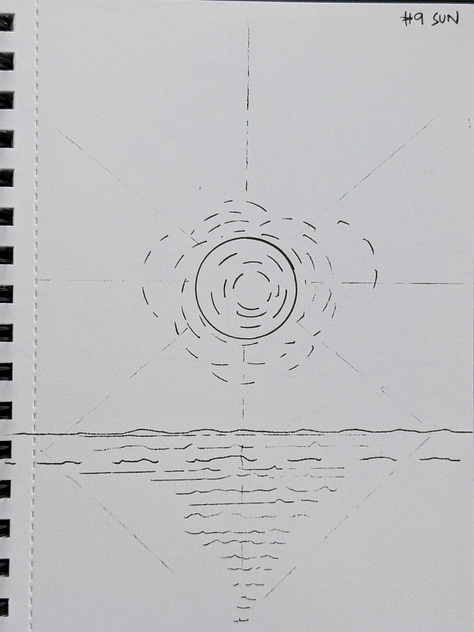How to (slowly) cultivate a fiction newsletter: part 2
Some more thoughts from 3 years of publishing
There’s a reason I’ve used the word ‘cultivate’ in the title of these articles, rather than ‘grow’, or any of the other icky LinkedIn-style corporate terms.
Every time I’ve started to think of this newsletter in the context of ‘growth’, I’ve become less happy. It feels like a distraction. Growth for growth’s sake is a soulless endeavour. I prefer to think of my newsletter more like a garden, or a plant, which requires care and attention, but is its own entity, and will likely to do its own thing regardless of my efforts. It’s slow, and unpredictable, but rewarding in the long run.
Pursuing growth and making it your primary motivation will take you down dark, dead-end alleys. Better to focus on the writing, on what you really love to do, and let that cultivation happen as a natural process of the care you’re already putting into the work.
The first part of my thoughts on this are here, if you missed them:
Let’s crack on with some more observations from the last three years of writing this newsletter. As before, you should feel absolutely comfortable with disregarding any of these that don’t sit right with you:
Get the model right
Fiction is a hard sell, simply because there’s so damned much of it. There’s abundant choice, at every price point. A lot of it is very good, and has decades-strong industries powering it.
When I started publishing my fiction on my own little newsletter, I wasn’t sure how to present it, or package it up. I’m a firm believer that artists should be paid for their work, and that art has real value.
At the same time, I’m a realist. Presented with infinite choice, why would anyone choose to pay to read Simon K Rando’s stuff?
There are various models I tried out, none of which worked well for me:
Fully paywalled: My first plan was to make the opening chapters free, then paywall the rest of the story. The idea being that if people enjoyed the first five-or-so chapters, they’d then subscribe to read the rest. What actually happened is that the paywalling of new chapters made it impossible for me to usefully promote the book. With serial fiction, each new chapter has the potential to be a mini-book launch, and I was sabotaging that.
Early access: I then tried making chapters available early to paid subscribers, before unlocking after a couple of weeks for everyone else. The theory being that if someone was really into the story, they’d pay to read ahead. Nope. It just made promoting the story unnecessarily complicated — again.
Partially paywalled: I experimented with paywalling chapters halfway down, but that always felt like the worst of all worlds. Annoying for free readers, and annoying people isn’t a good way to convince anyone to take out a paid sub.
Paywalled bonus material: I liked this idea, whereby the fiction would always remain free to read, with behind-the-scenes bonus material kept behind a paywall. That way, paid subs get special behind-the-curtain access, but everyone is still free to enjoy the story itself. This didn’t quite work for technical reasons: adding a paywall on Substack restricts comments to paid subscribers only, which was a bit of a deal-breaker.
Free: After six months of trying out all these different approaches, I ended up simply making everything free. This made it vastly easier to promote the book, thus attracting more readers. Unexpectedly, this is also when I started to see paid subscriptions coming through.
It confused me for a long time. Why were people paying for a subscription when the vast majority of my material was free to read? Why was making everything free seemingly more effective than paywalling it?
I think it comes down to a flipping of perspective. I suspect the lovely paid subscribers to this newsletter (hello! *waves*) consider it as an act of patronage. It’s a declaration of “I like what you do, keep doing it.”
In other words, it’s not a product exchange. They’re not ‘buying’ a ‘product’. They’re becoming patrons, of a sort. They’re invested in the process more than the output.1
That’s my theory, anyway. It’s what’s worked for me. Now, I suspect that once you hit a certain level of success and/or visibility, you can probably flip it back the other way. People would pay to read a new Margaret Atwood story via her newsletter, for example. But for new writers, and low profile writers, I’m fairly convinced that going free is the way to go, at least at first.
Stay on target
There’s two parts to this tip.
Firstly, if you can make each individual newsletter have a clear purpose, that always helps.
In the context of fiction, that can be as simple as being a new chapter of a story. But if a reader is expecting to read a new chapter, I’d advise against putting a ton of irrelevant chatter above the fold. I tend to keep all my natterings and behind-the-scenes stuff to below the chapter itself, so that readers can immediately find what they came for.
In the case of non-fiction, it means having a focused point, or question, or theme. Don’t try to make a post that is about five different things, as that’ll make it more difficult for it to find its audience and will confuse search engines.2
Secondly, be clear about your publication’s purpose. If you’re presenting yourself as a place to read fiction, then that’s what your subscribers expect. If you’re a publication that specialises in breaking news about Apple products, then that’s what your subscribers expect.
Suddenly mixing things up can cause confusion or annoyance. This can easily happen during major events, such as government elections. You might have very strong opinions, but if your newsletter isn’t about political essays, then it’s probably not the right venue.
This extends to Notes, in my opinion. You’re representing your publication when you post on Notes. The closer your Notes are thematically and contextually to your newsletter, the more likely you are to pick up interested subscribers.
None of this is to say that you can’t be yourself. Just be conscious of the audience you’ve been cultivating, and what they’re expecting. It’s about context.
Now, if your publication is presented from the start as being a freewheeling journal of sorts, then it’s less of an issue. In that situation the newsletter is the sum of your thoughts, so anything goes. But if you’ve declared “come here to read short fiction”, make sure you stay on target.
Onboarding, navigation and CTAs
What makes sense to you won’t necessarily make sense to your readers. I wrestled with this for far longer than I should have, as my serial Tales from the Triverse got longer each week.
There are three aspects to check, if you’re to make the process of reading and subscribing as simple as possible for your readers.
Onboarding: Make sure your automated welcome emails are friendly, useful and sound like you. Don’t leave them with the default text! In the welcome email, put links to your top articles, or the first chapters of your stories — whatever will point new readers in the right direction.
Navigation: On your publication’s website, and within individual posts, make sure your navigation is clear and simple. This is vital for long-time readers as well as new arrivals. If people can’t find what you’re doing, even when they’re on your site, then there’s a problem. Use sections, use the top nav, add additional links where needed.
CTAs: Judicious use of calls-to-action is recommended. Insert buttons that help people find their way (although don’t overload your posts) and link internally in the text if relevant. Good CTAs are signposts and shortcuts for readers. Make sure they’re nice and clear, unlike this one:
The longer you’ve been writing your newsletter, the more great stuff you’ll accumulate in your back catalogue. Don’t miss opportunities to highlight this to new readers, who might not even realise what you have available.
If you’re working on a long serial, indexes are a part of this. More info here:
Community and networking
If you’ve set up a fresh newsletter and don’t have any subscribers yet, it can feel like screaming into the void. People will arrive, but it could take a while.
A natural way to accelerate this is to engage in good, old-fashioned networking. That means joining conversations that are already happening, on Notes or in the comments sections of other newsletters. Don’t spam links to your own stuff, just take part in discussions like a normal human being.
If you’re contributing interesting points, people will want to find out who you are, which will lead them to your work. Hey presto, new readers.
In other words, don’t wait for people to come to you. Go to them first and say ‘hi’. You could make a start right here, right now, in fact.
External promotion
Especially when you’re starting out, you’re going to need to give yourself a boost in order to get over the inertia of having no audience.
That means going away from your newsletter and seeking readers elsewhere. If you’re using Substack, that means getting off Substack and remembering that the rest of the internet exists.
It’s trickier now that it has been in the past. Social media is largely useless, algorithmically designed to lock users in rather than send them off to interesting links. Some platforms are actively hostile, like X, suppressing any post that includes a Substack link.
My main tip here would be: don’t waste your time with social media, unless you actually enjoy it. If you enjoy using platforms from Meta, X, TiKTok etc, go for it — just don’t expect them to be particularly useful.

A promotional tool I did find very useful in my first couple of years was BookFunnel. This is where you can team up with other authors to set up group promos, leveraging your collective audiences, and inviting readers to check out your stuff. It’s not free, but it’s not expensive, and is likely to be more useful than spending your money on ads, or (even worse) your time on social media.
For context, 19% of my subscribers (just over 1k) are from ‘imported accounts’, which in my case is BookFunnel promos. I don’t use it anymore but I’m pretty sure it was a significant springboard at the start.
That’s all, folks
And so concludes my two-part, whistlestop tour of Things Wot I Have Noticed. It’s impossible to say whether these are legit observations, or simply me retroactively applying strategy and motive to random events, but hopefully you’ll find at least some of them useful.
I’ve mentioned
a few times recently, and can confidently recommend his book Shadow of the Wolf. He also has a newsletter, and I think this piece will speak to anyone who has spent any time trying to create…well, anything:I tried to do Inktober last month but was entirely defeated by getting ill. Most annoying. I did get up to day 10, though. Here are some of the sketches:



That one on the left — the guy sat on the sand wearing a hood — I was especially pleased with. I tried a more angular style, less concerned about realistic shapes, and I think it came out pretty good. Need to experiment more!
Right, I need to go and do some housework. Catch you all later in the week. Thanks for reading!
Aside: this is the aspect of creativity that the tech bros behind generative AI seemingly don’t understand.
Yes, I’m aware that this post and its predecessor are quite clearly ignoring this rule.










I was doing the whole "growth mindset" because that's what everyone and their aunt are preaching on social. Grow, scale, make sales, etc. Then a writing community on Facebook mentioned that I should check out Substack and Bluesky. Needless to say, I spend a lot less time on Facebook and Twitter. Like a fraction of what I used to. I love this place, and I'm learning so much.
Simon, you have me with the word ‘cultivate’ straightaway. Thank you for being such a reasoned contributor here, being fettered to ‘growth’ is what has gotten us in such trouble as a species.